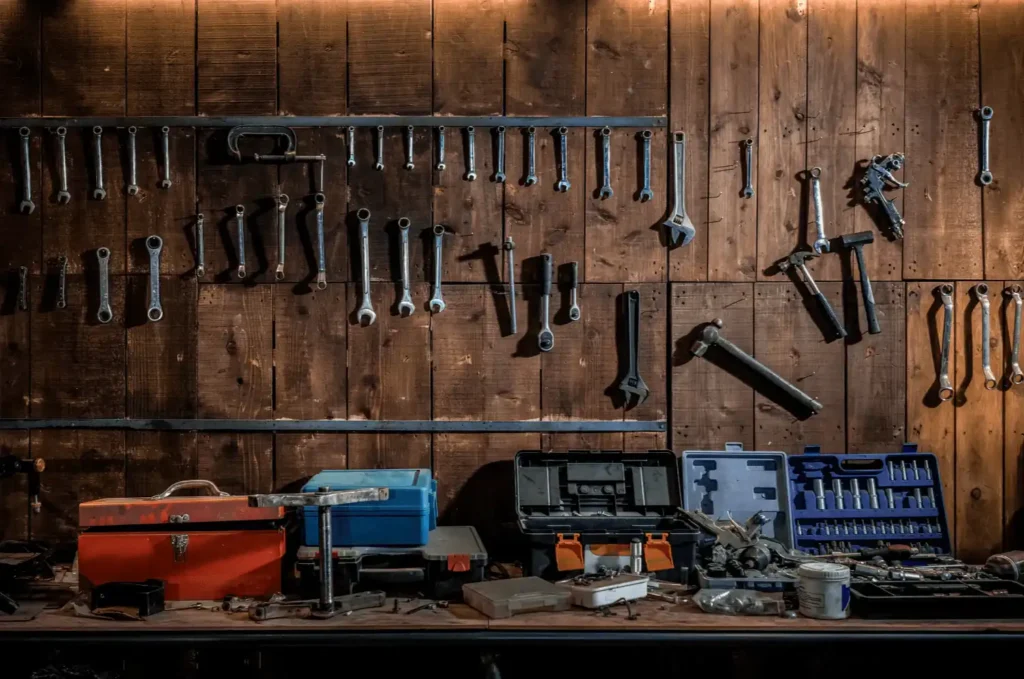Restoring a vintage car is more than just a hobby—it’s a labor of love. It takes precision, patience, and the right tools to bring a classic car back to life. Whether you’re working on a muscle car, a vintage sports car, or a classic truck, the right set of tools is crucial for completing a successful restoration. At Vintage Hammer Garage, we’ve spent years perfecting the restoration process, and over that time, we’ve learned that certain tools are absolute essentials when it comes to bringing a classic car back to its former glory.
In this blog, we’ll walk you through the top 10 must-have tools for restoring vintage cars, highlighting the equipment that makes the restoration process smoother, faster, and more efficient. Whether you’re a professional mechanic or a passionate DIYer, these tools will help you tackle any restoration project with confidence.
1. Impact Wrench
The impact wrench is a must-have tool when it comes to removing stubborn bolts and nuts, especially when working with rusty or worn parts. These heavy-duty tools use compressed air or electricity to provide high torque, making it easy to quickly remove lug nuts, bolts, and other fasteners without applying excessive force.
Why it’s essential: An impact wrench can save hours of manual labor, especially when dealing with the disassembly of older, rusted components. It’s a must for everything from removing tires to taking apart engine parts.
Top Features:
-
High torque for easy bolt removal
-
Variety of models, from electric to pneumatic
-
Essential for suspension work, wheel removals, and more
2. Floor Jack and Jack Stands
When working under a vintage car, safety is paramount. A floor jack is crucial for lifting the car to a safe working height, while jack stands provide the stability and security needed to keep the car elevated.
Why it’s essential: Lifting and securing a vehicle is one of the first tasks in any restoration. Having reliable equipment to ensure the car is properly supported while you work on it is key to both safety and efficiency.
Top Features:
-
Heavy-duty construction to handle the weight of classic cars
-
Low profile design for vehicles with a low ground clearance
-
Adjustable height for versatile use
3. Welding Machine
For many vintage cars, especially those suffering from rust or frame damage, welding is a critical skill in the restoration process. A welding machine allows you to repair metal components, fabricate new parts, and ensure that the structure of the car is solid once again.
Why it’s essential: Restoring the metal parts of a vintage car—whether it’s patching rusted panels or repairing structural components—requires welding. This tool is indispensable for anyone doing serious restoration work.
Top Features:
-
MIG or TIG welding options depending on the type of metal you’re working with
-
Adjustable settings for different thicknesses of metal
-
Includes safety features like automatic shut-off and fume extraction systems
4. Angle Grinder
The angle grinder is a versatile tool that is used for cutting, grinding, and polishing metal surfaces. When restoring a vintage car, this tool is invaluable for removing rust, smoothing out imperfections, and prepping parts for painting or welding.
Why it’s essential: Whether you’re stripping away old paint, grinding down rough edges, or cutting metal parts, an angle grinder makes the process much easier. It’s a tool you’ll reach for again and again throughout a restoration.
Top Features:
-
Multiple grinding and cutting attachments for various tasks
-
High RPM for quick and efficient grinding
-
Lightweight and ergonomic design for ease of use
5. Mechanic’s Tool Set
A comprehensive mechanic’s tool set is an absolute necessity for any restoration project. It includes a variety of wrenches, sockets, screwdrivers, and pliers that are used for disassembling and reassembling parts of the car.
Why it’s essential: Whether you’re working on the engine, suspension, or bodywork, you’ll need a full set of tools to remove and install various components. A high-quality mechanic’s tool set ensures you have the right tool for every job.
Top Features:
-
Includes sockets, wrenches, and ratchets in various sizes
-
Organized storage case for easy access to tools
-
Durable construction for heavy-duty use
6. Power Drill and Drill Bits
A power drill is another essential tool for any restoration project. It can be used for drilling holes, driving screws, and performing a variety of tasks that require precision. Having a set of high-quality drill bits in different sizes is also key for working with metal, plastic, or wood parts.
Why it’s essential: From installing new parts to repairing rust holes, a power drill is indispensable for working with fasteners and precision drilling. It saves time and ensures that holes are drilled correctly every time.
Top Features:
-
Variable speed for different applications
-
Multiple torque settings for precision work
-
Compatible with a wide range of drill bits
7. Compression Tester
A compression tester is a diagnostic tool that helps you assess the condition of your engine’s cylinders. It measures the compression pressure in the cylinders, which is vital for determining the engine’s health and performance.
Why it’s essential: When restoring a vintage car, checking the engine’s compression is crucial to ensuring that it runs efficiently and reliably. This tool allows you to identify potential issues with the engine before proceeding with further repairs.
Top Features:
-
Includes adapters for different engine types
-
Provides quick and accurate readings
-
Essential for diagnosing engine health before rebuilding
8. Sandblaster
For removing layers of old paint, rust, and debris from various parts of the car, a sandblaster is an invaluable tool. Sandblasting uses abrasive material to clean surfaces quickly and efficiently, making it perfect for restoring metal parts.
Why it’s essential: Sandblasting is much more efficient than manual sanding and can reach areas that are hard to access with other tools. It’s perfect for prepping parts for painting or welding.
Top Features:
-
Adjustable pressure settings for different surfaces
-
Portable and easy to maneuver
-
Works on a variety of materials, including metal, glass, and plastic
9. Paint Sprayer
When it comes to the final step of restoring a vintage car—painting—a high-quality paint sprayer is essential. It allows for smooth, even coats of paint that are necessary for a professional finish.
Why it’s essential: A paint sprayer can help achieve a flawless, factory-like finish on the car’s body, ensuring that the paint job is both durable and aesthetically pleasing.
Top Features:
-
Adjustable spray pattern for precision
-
High-efficiency nozzle for smooth application
-
Easy-to-clean system for minimal downtime
10. Diagnostic Scanner
Modern cars have onboard computers that can be diagnosed with a diagnostic scanner, but vintage cars often require more manual checks. However, having a basic diagnostic tool that helps identify electrical or sensor issues can be a game-changer.
Why it’s essential: For older vehicles that might have electrical issues, a diagnostic scanner helps you pinpoint problems with the car’s electrical system or sensors, saving time and effort during the restoration process.
Top Features:
-
Easy-to-use interface
-
Can identify a wide range of issues, from engine to electrical faults
-
Compatible with many vintage car models
Conclusion
Restoring a vintage car is a rewarding project, but it requires the right tools to ensure success. At Vintage Hammer Garage, we rely on these top 10 must-have tools to bring classic cars back to life with precision and craftsmanship. Whether you’re disassembling parts, welding frames, or applying the perfect paint job, the tools listed above are essential for achieving the high-quality results that every vintage car deserves.

